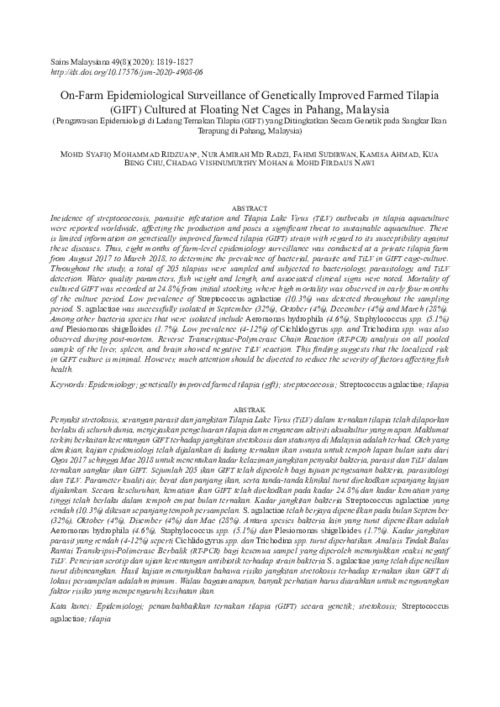On-farm epidemiological surveillance of genetically improved farmed tilapia (GIFT) cultured at floating net cages in Pahang, Malaysia

Incidence of streptococcosis, parasitic infestation and Tilapia Lake Virus (TiLV) outbreaks in tilapia aquaculture were reported worldwide, affecting the production and poses a significant threat to sustainable aquaculture. There is limited information on genetically improved farmed tilapia (GIFT) strain with regard to its susceptibility against these diseases. Thus, eight months of farm-level epidemiology surveillance was conducted at a private tilapia farm from August 2017 to March 2018, to determine the prevalence of bacterial, parasite and TiLV in GIFT cage-culture. Throughout the study, a total of 205 tilapias were sampled and subjected to bacteriology, parasitology, and TiLV detection. Water quality parameters, fish weight and length, and associated clinical signs were noted. Mortality of cultured GIFT was recorded at 24.8% from initial stocking, where high mortality was observed in early four months of the culture period. Low prevalence of Streptococcus agalactiae (10.3%) was detected throughout the sampling period. S. agalactiae was successfully isolated in September (32%), October (4%), December (4%) and March (28%). Among other bacteria species that were isolated include Aeromonas hydrophila (4.6%), Staphylococcus spp. (5.1%) and Plesiomonas shigelloides (1.7%). Low prevalence (4-12%) of Cichlidogyrus spp. and Trichodina spp. was also observed during post-mortem. Reverse Transcriptase-Polymerase Chain Reaction (RT-PCR) analysis on all pooled sample of the liver, spleen, and brain showed negative TiLV reaction. This finding suggests that the localized risk in GIFT culture is minimal. However, much attention should be directed to reduce the severity of factors affecting fish health.
Permalink
Date Available
Type
Publisher
Countries
ISSN
0126-6039
Copyright
CC-BY-4.0
Research Themes